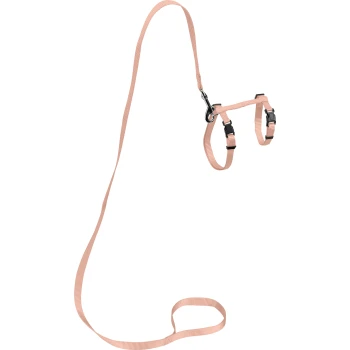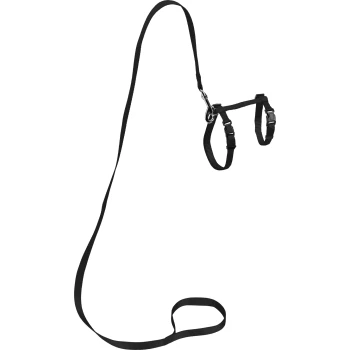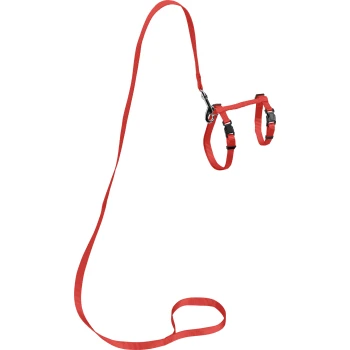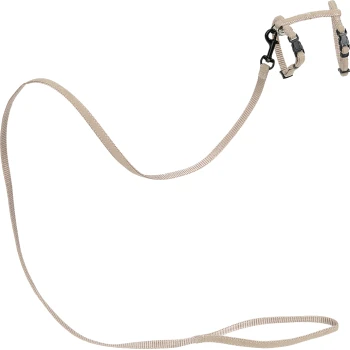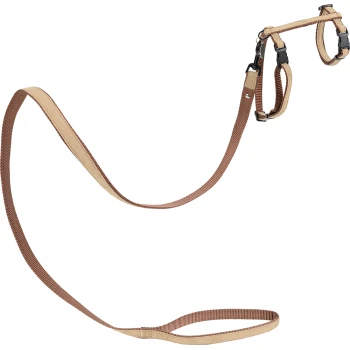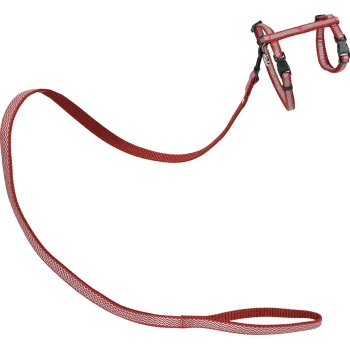Harnesses and leads for cats
Cat harnesses & cat leads at the Maxi Zoo online shop
When can it make sense to use a cat harness?
Although cat harnesses and leads are not essential items, many cat owners are increasingly finding them to be a good way of allowing their cats to move freely even if they don’t have their own garden. In addition, it can be more pleasant for some cats to wear harnesses than to be in a transport box – for example, for the journey to the vet. In addition, young cats with harnesses and leads can go safely and under control on their first discovery tours in the open air. And if a cat who loves freedom is unable to roam the neighbourhood due to an illness, owners can still enable them to move around freely in this way. A holiday with cats is also conceivable – at least if your cat is the type for it. In such a case, cat harnesses and leads should definitely be included in the luggage, to prevent your cat from getting lost in an unfamiliar area.
There are many applications for harnesses and leads for cats. It therefore makes sense to get familiar with these cat accessories, whether you have a house cat or an outdoor cat. At the Maxi Zoo online shop, you can choose from different models and can purchase the right accessories for excursions with your cats, all online.
Size, material, locking mechanism: find the right harness combination for your cats
When choosing cat harnesses, the quality of fit is always the top priority: each harness must sit comfortably and very securely on your cat. Since cats get frightened easily and may jump up and hurt themselves, cat harnesses must sit absolutely precisely: not so tight that the cat is constricted or can no longer move properly, nor so loose that it could slip out and escape. As a rule, precise dimensions are quoted and you just have to measure your cat before you buy one. First and foremost, the diameter of the neck, chest and abdomen are relevant for this. But you also have to measure the length of the upper body for certain models and designs of harness. Around the neck and abdomen, it is usually possible to adjust the width of cat harnesses slightly.
The shape: generally speaking, there are two different types of cat harness: chest harnesses and harnesses that comprise two interconnecting rings, one serving as a cat collar and the other as a waist belt. The two parts are usually connected via a thin strap that runs between the shoulder blades. In the case of chest harnesses, a strap that is usually wider and padded runs under the cat’s chest. These harnesses are usually more comfortable for cats because the pull on the lead is directed across the chest and is distributed better. In addition, these harnesses generally make it harder for the cat to escape.
The material: cat harnesses are usually made of nylon or similar soft but robust material. Simple models have thin belts, while others offer more comfort with wide and padded straps. The latter are the first choice for long excursions. Simple cat harnesses are usually sufficient if your cat only wears them rarely and over a short period of time. Or when your lounge tiger is walking on a lead in a very relaxed manner without causing it to get taut.
Securing a harness: cat harnesses vary in shape and also in the securing mechanisms they employ. A snap-on connector is a common and very safe option. These are easy to operate and you can put on and take off the harnesses quickly. There are also models with burr fasteners. Here, a strong and securely closing burr fastener (e.g. Velcro) is essential. The burr surface area should not be too short. Some cats do not like the sound a burr fastener makes when opening. Then again, these dispense with hard plastic parts, making burr fasteners more comfortable for cats.
The cat lead specifies the movement radius
The weight is the most important characteristic of cat leads. Cats are light and want to move freely: no cat has any wish to drag a heavy lead along behind them. There are basically two different types of cat lead: leads made of lightweight nylon or a similar material, of fixed length, or with extending roller cables with a so-called short-stroke braking system. On the latter, there is always a slight pull which enables the lead to roll up by itself without dragging along the ground. As a result, it only ever extends out of the holder to the extent that your cat moves away from it. With these extending leads, always ensure that they do not exert too much tension, enabling your cat to continue moving freely.
The total length of the cat lead is mainly a matter of taste and also depends on your cat’s urge to explore. A short lead provides safety for your first excursions – with more practice and routine you can then gradually give your cat a wider radius of movement.
When should you get your cat used to its harness?
If you adopt a young cat, you should familiarise it with a harness and a lead as soon as possible. The sooner it gets used to a lead, the easier your cat will find it to accept wearing it. Once familiarised, you should continue to use a lead on a regular basis, even with cats that are used to roaming freely to ensure that your house cat does not unlearn what you have taught. Then you can use these accessories if your cat falls ill, or travels with you on holiday.
Older cats can also get used to leads and harnesses with a lot of patience. However, depending on the character of your cat, this can take longer than in kittens. Some cats are too anxious or nervous and never get used to it: you should respect that. After all, you want to make your cat happy with harness and lead, for example to enable them to have more liberty of movement than they would otherwise have. However, if your cat only ever gets stressed wearing a cat harness, you should accept this and look for other forms of activity.
How do I get my cat used to a harness and a lead?
Above all, cats need to be allowed to take their time. Before you put the cat harness on your house cat for the first time, just show the harness first. For example, place the harness on the sofa, then let your cat taste it and play with it. After a few days, put the harness onto your cat without fastening it. Praise your cat abundantly and reward it with treats. Continue step by step until the cat can wear its harness without signs of discomfort or even fear. Extend the intervals during which your cat wears the harness at home – always under careful supervision. Some cats could get snagged if they try to dislodge the harness or hide away to escape from this alien body.
Tip: if you do clicker training with your cat, you can incorporate the harness into those exercises. Older cats in particular can often get used to cat harnesses more easily in this manner.
As soon as the cat is moving normally while wearing a harness and is clearly not uncomfortable with it, you can put it on a lead. You should also only do this at home before making your first outdoor excursion. You should do this in a quiet place and ideally on a fenced-in property. This is because, when your cat is out and about in the open air for the first time, it will be bombarded by a host of new impressions and this can quickly overwhelm it. Some cats might then liberate themselves from the harness faster than their owner might have believed to be possible.
You can buy high-quality and safe cat harnesses online – in the Maxi Zoo online shop you will find various cat dishes and cloths from manufacturers such as AniOne and Hunter.

